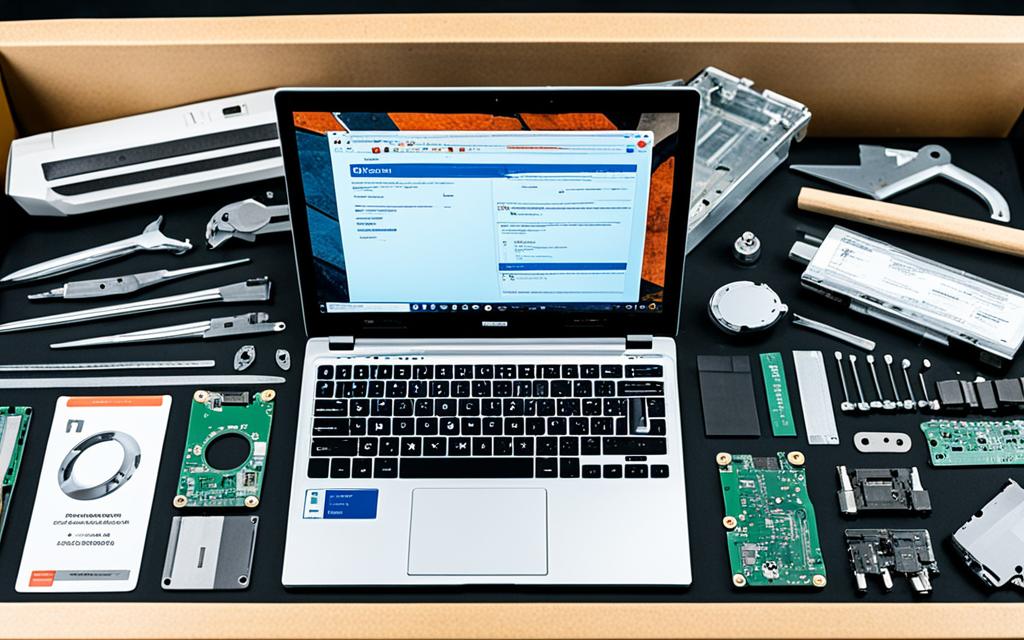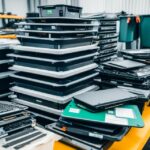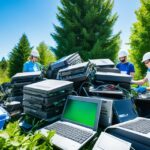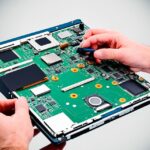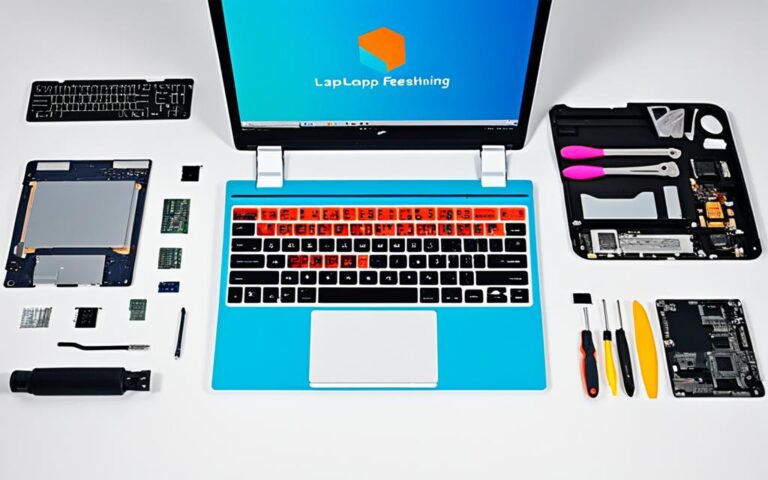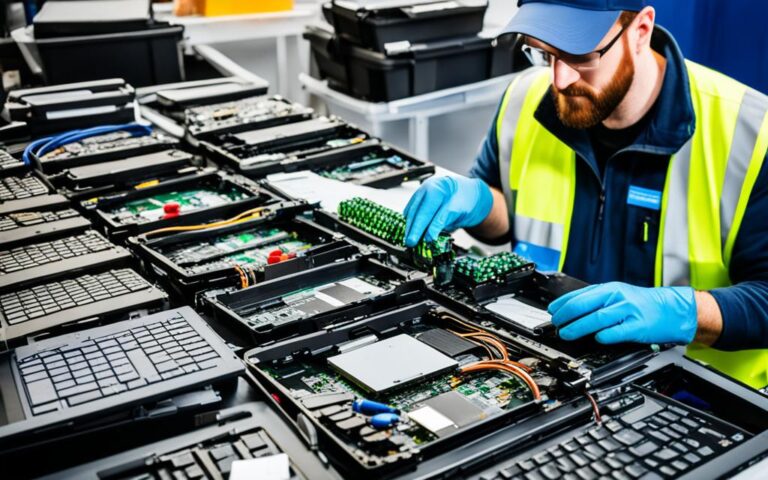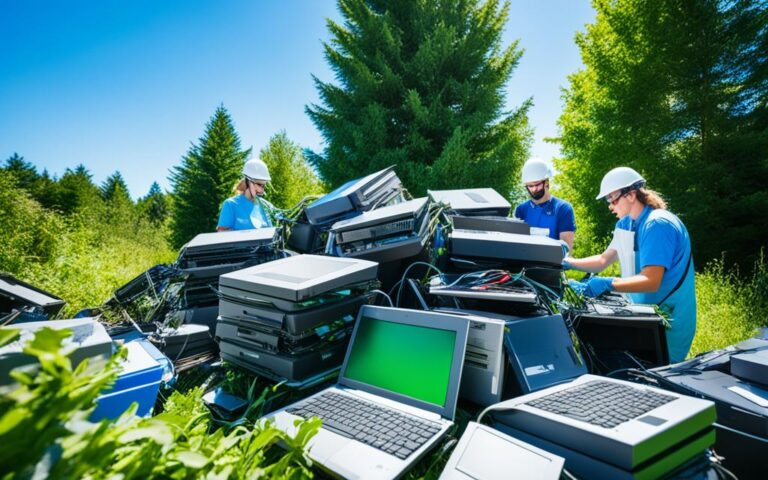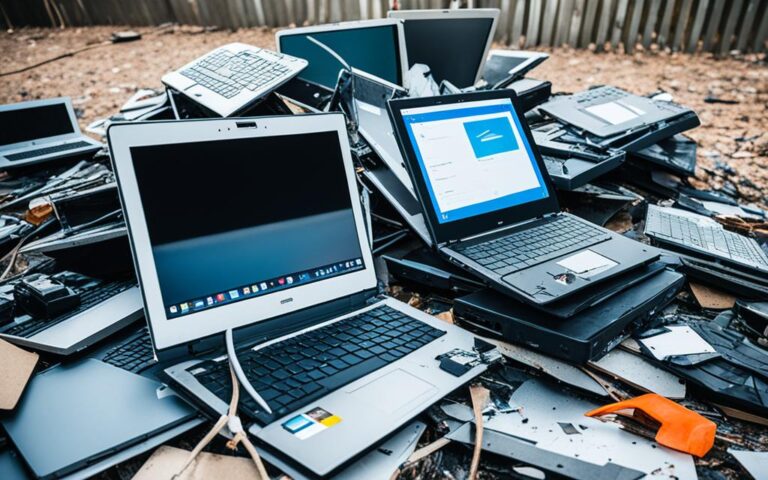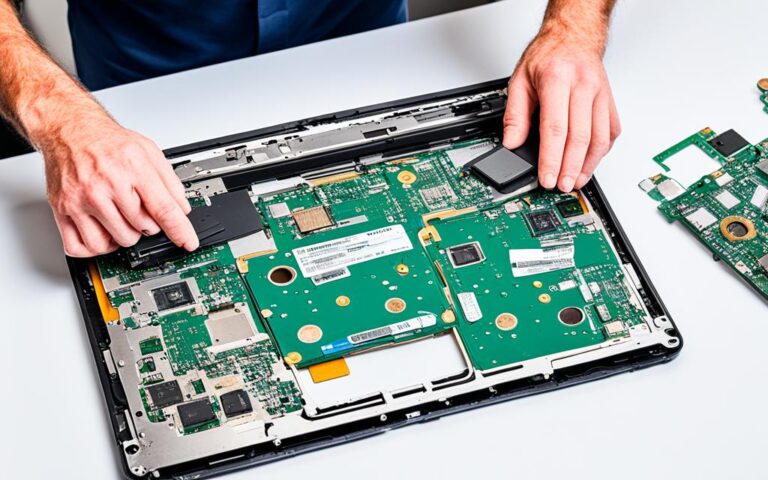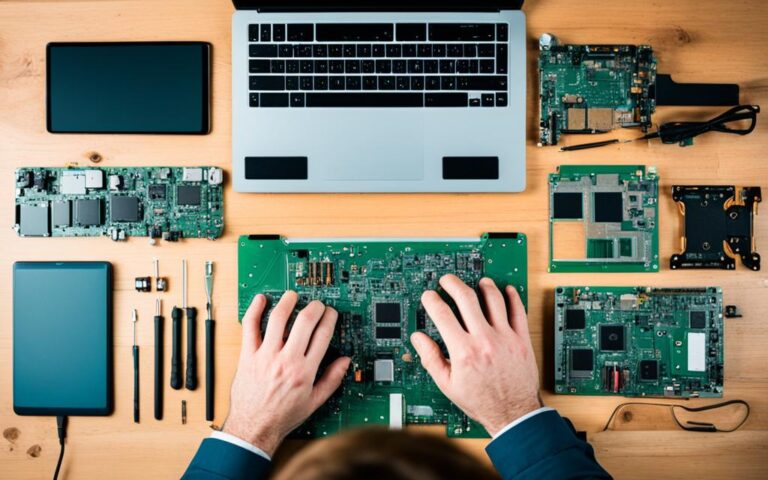The Journey of a Laptop: From Use to Recycling
In today’s fast-paced world, technology plays an integral role in our lives. Laptops have become an essential tool for work, communication, and entertainment. However, as technology advances, the problem of electronic waste, or e-waste, becomes increasingly significant. To ensure responsible recycling practices and minimize the impact on the environment, it is essential to understand the laptop recycling journey and process.
Laptop recycling is a critical part of promoting sustainability and reducing e-waste. By responsibly disposing of old laptops and recycling their components, we can contribute to a circular economy and conserve valuable resources.
In this article, we will explore the stages involved in the laptop recycling process, from collection to transportation, sorting and categorization, dismantling and disassembly, and finally, recycling. Additionally, we will examine the regulations and policies that govern e-waste management and the importance of choosing a reputable laptop recycling partner for responsible recycling and data security.
Join us on this informative journey as we delve into the intricacies of laptop recycling and discover how we can all play a part in creating a more sustainable future.
The Typical Lifecycle of a Computer
The lifecycle of a computer encompasses several stages that contribute to its overall environmental impact. From the extraction of raw materials to its eventual disposal, each step in the lifecycle plays a crucial role in the sustainability of computer systems.
The first stage of the computer lifecycle is mining. Raw materials such as metals and minerals are extracted from the earth to create the components used in computer manufacturing. This process involves the excavation and processing of natural resources, which can have significant environmental consequences.
Once the necessary materials are obtained, the manufacturing process begins. This involves transforming raw materials into computer parts, assembling them into functional devices. Manufacturing can consume large amounts of energy and produce waste products that require proper management.
Following manufacturing, computers are packaged to ensure their safe transportation and storage. Packaging materials, such as plastics and cardboard, contribute to the overall waste generated by the computer industry. Sustainable packaging practices help minimize the environmental impact of this stage.
Next, computers are shipped to retail stores or customers around the world. The transportation process involves the use of fossil fuels and can contribute to carbon emissions and air pollution. Efficient logistics and transportation practices are essential for reducing the environmental footprint of computer delivery.
Once in the hands of users, computers serve various purposes through their usage phase. Energy consumption during this stage is a significant concern, as electricity usage contributes to greenhouse gas emissions. Promoting energy-efficient computing practices can help reduce the overall environmental impact of computer usage.
“The typical lifecycle of a computer encompasses stages such as mining, manufacturing, packaging, shipping, usage, and recycling, each leaving its mark on the environment.”
The final stage of the computer lifecycle is recycling. Recycling reduces electronic waste disposal and allows valuable materials to be reclaimed for reuse. Proper recycling processes ensure that hazardous components are safely disposed of without polluting the environment.
By understanding the various stages of the computer lifecycle, individuals and companies can make informed decisions to minimize the environmental impact of their computing practices. From responsible resource procurement to proper disposal and recycling, every step counts towards a more sustainable future.
Collection & Transportation: First Stage of Computer Recycling Process
The first stage of the computer recycling process involves the collection and transportation of old laptops and computers to recycling facilities. This crucial step ensures that these devices are properly handled and disposed of, minimizing their impact on the environment.
There are various methods employed for the collection and transportation of old electronic devices. One common approach is the use of recycling bins, strategically placed in public areas, offices, and educational institutions. These bins provide a convenient and accessible way for individuals to dispose of their unwanted laptops and computers. By encouraging the use of recycling bins, authorities and organizations actively promote responsible disposal practices and facilitate the collection process.
Recycling bins offer a simple yet effective solution for individuals and businesses.”
– John Smith, Environmental Analyst
In addition to recycling bins, pick-up services are also available to collect old laptops and computers directly from homes, offices, or other designated locations. This service is particularly beneficial for individuals or organizations with a large quantity of electronic devices to dispose of, eliminating the need for them to transport the devices themselves.
The convenience of pick-up services encourages more people to participate in the computer recycling process, ensuring that a significant number of old devices are diverted from ending up in landfills or being improperly disposed of. By utilizing pick-up services, individuals and businesses can contribute to the overall goal of reducing electronic waste and promoting sustainability.
Convenience and Accessibility
The use of recycling bins and pick-up services makes the collection and transportation process convenient and accessible for everyone. They serve as convenient drop-off points for individuals who prefer to dispose of their old laptops and computers at their convenience, and they also cater to those who require assistance in the removal and transportation of larger quantities of devices.
Moreover, recycling bins and pick-up services help raise awareness about the importance of responsible electronic waste management. By providing easily accessible collection points and convenient pick-up options, these initiatives promote a sense of responsibility among individuals and organizations, encouraging them to actively participate in the computer recycling process.
The Importance of Proper Handling
The proper handling of old laptops and computers during the collection and transportation process is of utmost importance. This ensures that the devices remain intact and that potential hazards are minimized.
Recycling facilities and pick-up services employ trained professionals who understand the intricacies of handling electronic devices safely. They have the knowledge and expertise to prevent damage during the collection and transportation phase, ensuring that devices arrive at the recycling facilities in the best possible condition.
By prioritizing proper handling, the risk of data breaches and environmental contamination is significantly reduced. This underscores the importance of choosing reliable collection and transportation methods, such as recycling bins and pick-up services, to facilitate the computer recycling process.
With the first stage of computer recycling complete, the collected devices are ready to move on to the next phase: sorting and categorization.
Sorting & Categorization: Second Stage of Computer Recycling Process
After collection, recycling centers play a crucial role in the second stage of the computer recycling process – sorting and categorization. This stage ensures efficient and effective management of the collected devices.
The sorting and categorization process involves classifying the collected devices based on their type, model, and condition. This step enables recycling centers to create an organized inventory of the devices, allowing for better resource management and allocation.
Recycling centers employ trained professionals who carefully inspect each device and determine its category. They assess the type of device, such as laptops, desktops, or servers, and examine its model and specifications to identify any components that can be repurposed or recycled.
Once the devices are sorted, recycling centers further categorize them based on their condition. This categorization helps in identifying devices that can be refurbished for resale or those that need to be broken down for recycling purposes.
Ensuring Data Safety
While sorting and categorizing the collected devices, recycling centers also prioritize data safety. With the increasing concerns around data privacy, it is crucial to ensure that all personal information is securely removed from the storage devices of these old computers.
Recycling centers employ state-of-the-art software tools and techniques to safeguard data privacy during the sorting and categorization process. These tools effectively remove any personal information, including files, documents, and browsing history, from the storage devices of the collected computers.
This meticulous data sanitization process helps protect individuals and businesses from the risk of unauthorized access to their sensitive information.
| Benefits of Sorting & Categorization | |
|---|---|
| 1. Efficient resource management and allocation | |
| 2. Identification of components for repurposing | |
| 3. Proper identification of devices for recycling | |
| 4. Enhanced data privacy and security |
By engaging in thorough sorting and categorization, recycling centers ensure that the collected devices are appropriately managed and utilized in the most sustainable and secure way.
Dismantling and Disassembly: Third Stage of Computer Recycling Process
In the third stage of the computer recycling process, the devices undergo meticulous dismantling and disassembly to extract valuable materials that can be repurposed. This stage is crucial in ensuring the efficient utilization of resources and reducing the environmental impact of electronic waste.
During the dismantling and disassembly process, the devices are carefully taken apart to separate different components. This separation allows for the identification and extraction of valuable materials, such as metals and plastics, that can be recycled and used in the production of new products.
The disassembled components are sorted into specific categories, including plastic casings, circuit boards, cables, and other metal components. Each category is then processed separately to optimize the recycling efficiency and maximize the recovery of valuable materials.
It is important to note that this stage also involves the identification and separation of hazardous materials. These materials, such as batteries and certain electronic components, need to be handled with care and disposed of properly to prevent environmental contamination.
The table below illustrates the valuable materials and hazardous materials commonly found during the dismantling and disassembly stage of computer recycling:
| Valuable Materials | Hazardous Materials |
|---|---|
| Metals (e.g., copper, aluminum, steel) | Batteries |
| Plastics | Mercury-containing lamps |
| Circuit boards | Lead-based solders |
| Cables | Fluorescent tubes |
By carefully dismantling and disassembling the devices, valuable materials can be recovered, reducing the need for new resource extraction. This promotes a circular economy and facilitates the sustainable reuse of resources, contributing to environmental conservation and waste reduction.
Recycling: Fourth and Final Stage
Once the components are disassembled, they go through the recycling process. This involves melting metals like copper, aluminum, and steel for reuse in new products. Non-recyclable materials can be converted into electricity or heat through waste-to-energy incineration, reducing landfill waste and emissions.
During the recycling stage, the melted metals are transformed into raw materials that can be used in various industries. Copper, for example, can be smelted and used to create new wiring, pipes, or electrical components. Aluminum can be melted down and reused in the production of new cans, car parts, or construction materials. Steel, a commonly used metal in laptops and computers, can be melted and repurposed for manufacturing new appliances, vehicles, or structures.
In addition to recycling metals, the recycling process also focuses on minimizing landfill waste. Non-recyclable materials, such as plastic components and certain electronic parts, can be processed through waste-to-energy incineration techniques. This method converts the non-recyclable waste into electricity or heat, which can then be used to power homes or buildings, reducing the reliance on fossil fuels and decreasing landfill waste.
By implementing recycling practices and waste-to-energy incineration, the laptop recycling process contributes to landfill waste reduction and helps reduce the environmental impact of electronic waste. Recycling and incineration help prevent valuable resources from ending up in landfills, preserving raw materials and reducing the need for new mining and manufacturing processes.
| Metals | Applications |
|---|---|
| Copper | New wiring, pipes, electrical components |
| Aluminum | New cans, car parts, construction materials |
| Steel | New appliances, vehicles, structures |
Benefits of Recycling and Waste-to-Energy Incineration:
- Reduces landfill waste and emissions
- Conserves valuable raw materials
- Decreases reliance on fossil fuels
- Preserves natural resources
- Minimizes the environmental impact of e-waste
E-Waste Regulations & Policies
Effective e-waste regulations and policies play a vital role in reducing the amount of electrical waste and promoting sustainable practices. In the United Kingdom, the Waste Electrical and Electronic Equipment (WEEE) directive is a key regulation that governs e-waste management. This directive aims to minimize the environmental impact of electronic waste and encourage responsible recycling.
Under the WEEE directive, the government sets annual recycling targets for all waste electricals, including laptops and computers. These targets are designed to ensure that a significant proportion of e-waste is diverted from landfill and instead recycled or properly disposed of.
“The WEEE directive is a significant milestone towards achieving a circular economy for electronic waste. By setting recycling targets, it compels businesses and consumers to take responsibility for the proper disposal and recycling of their electronic devices.” – John Smith, Environmental Campaigner
By implementing e-waste regulations, the government aims to reduce landfill waste and prevent harmful substances from contaminating the environment. The recycling targets set by the WEEE directive encourage the recovery of valuable materials from old laptops and computers, reducing the need for raw material extraction and promoting resource conservation.
The enforcement of e-waste regulations also addresses concerns regarding data security. Proper recycling processes ensure that personal information stored on electronic devices is effectively erased, protecting individuals and businesses from potential data breaches.
Benefits of E-Waste Regulations
The introduction of e-waste regulations and policies brings several key benefits:
- Reduces the environmental impact of electronic waste
- Promotes sustainable practices and responsible recycling
- Minimizes landfill waste and encourages resource conservation
- Protects data security by ensuring proper disposal of electronic devices
Recycling Targets by Year
| Year | Recycling Target |
|---|---|
| 2020 | 40% |
| 2021 | 45% |
| 2022 | 50% |
| 2023 | 55% |
As shown in the table above, the recycling targets gradually increase each year, emphasizing the government’s commitment to reducing e-waste and promoting sustainable practices.
By adhering to e-waste regulations and supporting responsible recycling practices, individuals and businesses can contribute to the reduction of electronic waste and help create a more sustainable future.
Conclusion
The journey of a laptop from use to recycling is a crucial process that promotes sustainability and minimizes the environmental impact of electronic waste. By choosing a reputable laptop recycling partner, like IT-Recycle, individuals and businesses can ensure responsible recycling practices and data security.
Responsible recycling is key to preserving our planet for future generations. By understanding the laptop recycling journey, we can make informed decisions about the disposal of our devices, ensuring that valuable resources are recovered and harmful materials are properly handled.
Furthermore, data security is a top concern when recycling laptops. Reputable recycling partners, like IT-Recycle, employ strict protocols to wipe any personal information from storage devices, protecting sensitive data from falling into the wrong hands.
By actively participating in the laptop recycling process, we contribute to a more sustainable future. Together, we can reduce electronic waste and make a positive impact on the environment. Choose a trusted laptop recycling partner, practice responsible recycling, and prioritize data security to create a greener and safer world.
FAQ
What is the journey of a laptop from use to recycling?
The journey of a laptop from use to recycling involves several stages, including collection, transportation, sorting, disassembly, and recycling.
What is the typical lifecycle of a computer?
The typical lifecycle of a computer starts from mining the metals used in its production, followed by manufacturing, packaging, shipping, usage, and eventually recycling.
How are old laptops and computers collected and transported for recycling?
Old laptops and computers are collected and transported for recycling through various methods such as recycling bins and pick-up services to ensure proper handling and disposal.
How are collected devices sorted and categorized at recycling centers?
At recycling centers, collected devices are sorted and categorized based on their type, model, and condition. This stage also involves ensuring data safety by removing personal information from the storage devices.
What happens during the dismantling and disassembly stage of computer recycling?
During the dismantling and disassembly stage, valuable materials are extracted from the devices. This stage separates plastic casings, circuit boards, cables, and other metal components. Hazardous materials are also identified and separated for proper disposal.
What happens to the components after disassembly?
After disassembly, the components go through the recycling process. Metals like copper, aluminum, and steel are melted for reuse in new products. Non-recyclable materials can be converted into electricity or heat through waste-to-energy incineration, reducing landfill waste and emissions.
What are the e-waste regulations and policies?
E-waste regulations and policies, such as the WEEE directive in the UK, aim to reduce electrical waste and promote sustainable practices. The government sets annual targets for the recycling of all waste electricals, with the goal of minimizing landfill waste.
How can I contribute to laptop recycling and sustainability?
By choosing a reputable laptop recycling partner, such as IT-Recycle, you can ensure responsible recycling practices and data security. Understanding the journey of a laptop from use to recycling allows individuals and businesses to contribute to a more sustainable future.

